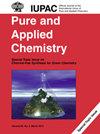Selection of graphene as a conductive additive for biomass-based activated carbon electrode in capacitive deionization: acid-treated as a practical approach to reduce graphene content
IF 2
4区 化学
Q3 CHEMISTRY, MULTIDISCIPLINARY
引用次数: 0
Abstract
The use of graphene (GE) as a conductive additive for activated carbon (AC) electrode in capacitive deionization (CDI) has attracted much attention due to its high electrical conductivity. However, self-agglomeration by π–π interactions between individual GE sheets required the use of high content to ensure an efficient conductive network in the electrode, which limited its practical application. This work proposed an approach to reduce the GE content in the fabrication of biomass-based activated carbon electrode for CDI application. The stacking effect of GE sheets is inhibited when GE sheets functionalize with oxygen groups via acid treatment under ultrasonic condition. This helps to reduce GE content to less than 2 wt% in the fabrication of CDI electrodes. The electrode fabricated using 2 wt% treated GE (T-GE) achieved the superior capacitance of 54 F/g, twice that of the pristine AC. The desalination process using as-prepared electrodes was evaluated by batch-mode CDI system with the initial NaCl solution of 2000 ppm and 3000 ppm at various applied voltages. The AC/T-GE 2 % electrode showed excellent performance with a desalination capacity greater than 10 mg/g, and reached an adsorption rate of 1.93 mg/g.min in both solutions under an applied voltage 1.2 V.选择石墨烯作为电容式去离子法中生物质活性炭电极的导电添加剂:酸处理是降低石墨烯含量的实用方法
石墨烯(GE)具有高导电性,因此在电容式去离子(CDI)中用作活性炭(AC)电极的导电添加剂备受关注。然而,单个 GE 薄片之间通过 π-π 相互作用而产生的自团聚要求使用高含量以确保电极中有效的导电网络,这限制了其实际应用。本研究提出了一种在制造用于 CDI 的生物质基活性炭电极时降低 GE 含量的方法。在超声波条件下,通过酸处理使 GE 片层具有氧官能团,从而抑制 GE 片层的堆积效应。这有助于在制造 CDI 电极时将 GE 的含量降至 2 wt% 以下。使用 2 wt% 处理过的 GE(T-GE)制造的电极电容高达 54 F/g,是原始 AC 的两倍。通过批量模式 CDI 系统,在初始 NaCl 溶液浓度为 2000 ppm 和 3000 ppm 时,在不同的应用电压下,对使用制备的电极进行的海水淡化过程进行了评估。AC/T-GE 2 % 电极表现出优异的性能,脱盐能力大于 10 mg/g,在 1.2 V 的应用电压下,两种溶液的吸附率均达到 1.93 mg/g.min。
本文章由计算机程序翻译,如有差异,请以英文原文为准。
求助全文
约1分钟内获得全文
求助全文
来源期刊

Pure and Applied Chemistry
化学-化学综合
CiteScore
4.00
自引率
0.00%
发文量
60
审稿时长
3-8 weeks
期刊介绍:
Pure and Applied Chemistry is the official monthly Journal of IUPAC, with responsibility for publishing works arising from those international scientific events and projects that are sponsored and undertaken by the Union. The policy is to publish highly topical and credible works at the forefront of all aspects of pure and applied chemistry, and the attendant goal is to promote widespread acceptance of the Journal as an authoritative and indispensable holding in academic and institutional libraries.
 求助内容:
求助内容: 应助结果提醒方式:
应助结果提醒方式:


